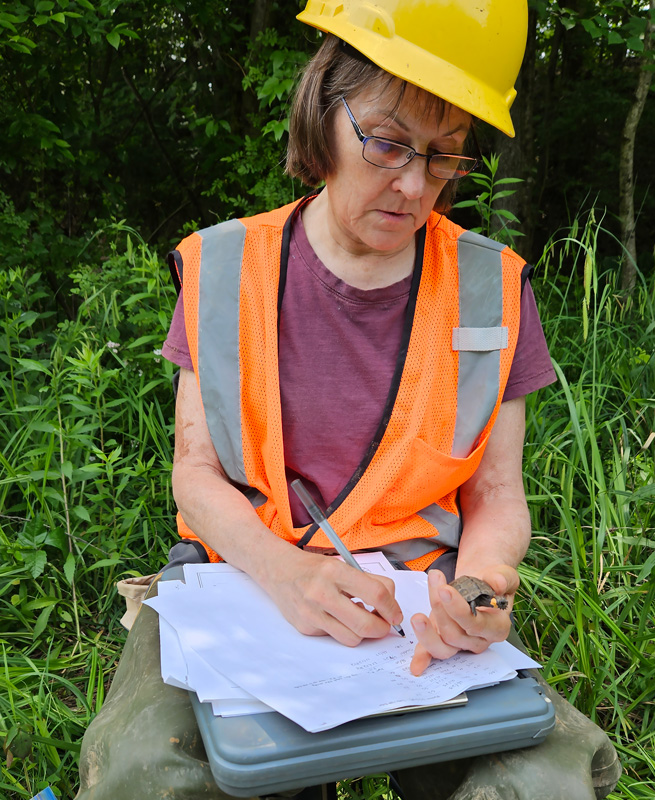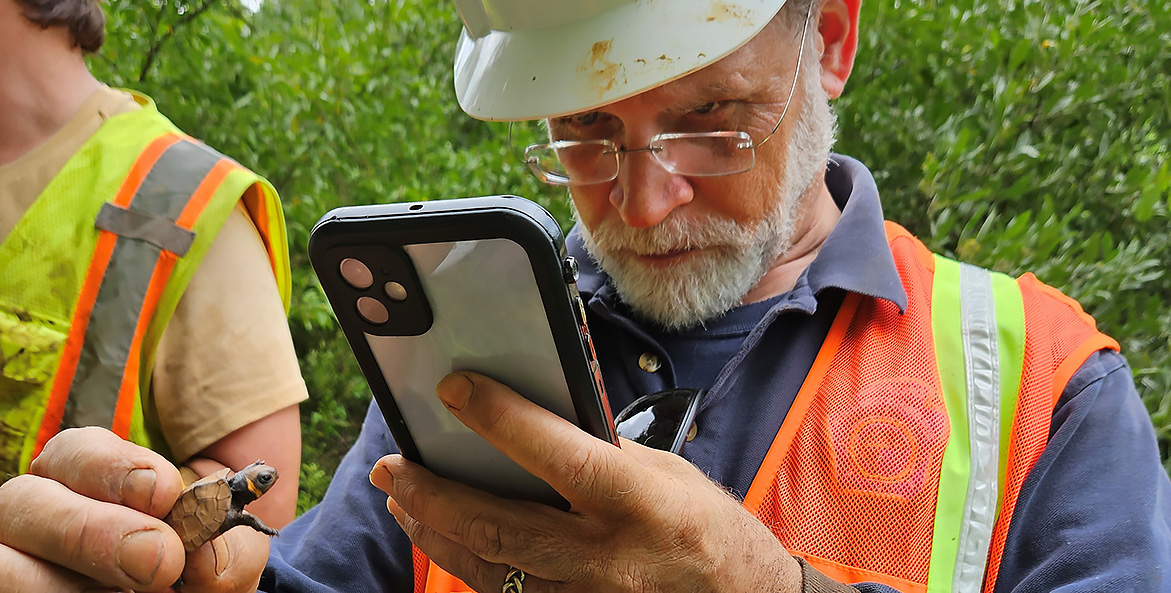On his knees in wetland mud, Chris Urban sorts through tufts of grass with his bare hands. Later, walking carefully, he taps into mud puddles with a long pole, listening and feeling for the telltale “thud” that he has found something.
Also in the wetland not far away, Lori Erb sits, clipboard and file in hand.
Urban and Erb were part of a team canvassing a wetland in eastern Pennsylvania on a sunny afternoon, looking for bog turtles or Glyptemys muhlenbergii.
The small three-to four-inch turtles are the tiniest turtles in the U.S. and are listed as endangered in Pennsylvania and threatened federally and in Maryland.
Much like brook trout and the Eastern hellbender, bog turtles are an indicator species of water quality.
“These turtles are headwater animals and usually, where you have bog turtles in wetlands, you have really good water quality,” Urban said. “It’s where they get their food, hibernate, where they forage and mate. Everything happens here.”
The area of this survey was in drought conditions, but still rather wet. “Bog turtles like the cold water and in wetlands are in stable systems,” Urban added. He is the Threatened and Endangered Species Coordinator for the Pennsylvania Fish and Boat Commission (PFBC), and a veteran of many amphibian and reptilian surveys.
Why care about a small bog turtle?
“We talk about bog turtles being a keystone species and providing habitat for other animals it lives with,” Urban said. “You take away those habitats and take away this animal, you wonder where the tipping point is, where you have a collapsing system.
I tell anglers, this is a headwater species, if you want good trout fishing you have to protect this species and you will protect your trout water. And those headwaters are shared with trout.
Erb works primarily with turtles for the Mid-Atlantic Center for Herpetology and Conservation (MACHAC). It is a non-profit that furthers conservation efforts for amphibians and reptiles through surveys, habitat management, and developing conservation plans.
During the wetland survey, Erb was examining, marking, and noting bog turtles found. Size, age, general health, and any injuries are evaluated. If it’s a first-time capture, the edge of the shell is notched as an identifying mark for future surveys.

Qualified bog turtle surveyor Lori Erb takes notes on the condition of a tiny bog turtle as part of a wetland survey in eastern Pennsylvania.
BJ Small/CBF Staff
Erb was also noting the condition of the turtles’ habitat. “Water quality is important and there are a lot of unique species like bog and spotted turtles, salamanders, eastern ribbon snakes, and lots of others here,” Erb said. “Because they are spring-fed and seep-fed wetlands, you’ve got freshwater bubbling up that starts streams. If that habitat is better, your downstream habitat is going to be better.”
“The health of our wetlands, rivers, and streams is directly related to the health of farms, forests, and fields that flow into them,” said Harry Campbell, CBF Science Policy and Advocacy Director in Pennsylvania.
“When natural areas are cleared of their native vegetation, stripped of their soils, and paved over for subdivisions and strip malls with manicured lawn or plowed over to grow crops on, the result is not only increased polluted runoff but a significant loss of habitat critical to a wide array of critters, like the bog turtle,” Campbell added.
Overgrowth of vegetation and loss of wet meadow habitat is a major threat to bog turtle survival. “Because of agriculture and industry, more nutrients have gone into wetlands and that has allowed for woody plants to take over,” Erb adds. “Then the canopy closes in, and it closes out the nesting habitat.” She considers less than 10 percent of the current bog turtle habitat to be in good condition and 67 percent as poor.
Nine bog turtles, including hatchlings, were found in the few hours of the survey.“ In any healthy population you want to have different cohorts and mixed age-classes,” Urban said. “We’ve been seeing that at most of our sites and here, too. It’s very encouraging.”
Unless they are discovered sitting atop the dry grass, bog turtles found in the muck and mud are often camouflaged or under grasses, if not submerged. They are not ready for a charismatic cameo in trademark deep, black tones and bright blotches of orange on their heads as most people know them. The small turtles are easier to find early in the year, before vegetation grows high in summer and fall.
Pennsylvania has some of the largest and most intact populations in the Northeast, with as many as 200 occurrences. To protect disappearing habitat, and because of their popularity on the illegal pet trade market, the whereabouts of bog turtle colonies are closely guarded secrets.
Yet, having the verified presence of threatened or endangered species like bog turtles brings added protection to the critter and water body from development and other threats.
As the landmark Comprehensive Evaluation of System Response (CESR) study—a report that is shaping the next stage of watershed restoration—recently highlighted: Healthy headwater streams are vital for the health of the Chesapeake. And they play a critical role in protecting the lowly bog turtle and countless other species that make this region so special.




